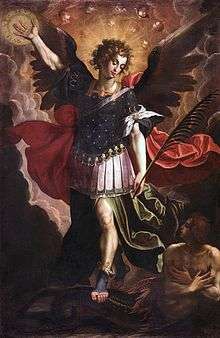Cristóbal Vela
Cristóbal Vela (c. 1588-1658) was a Spanish Baroque painter and gilder.

Cristóbal Vela | |
|---|---|
| Nationality | Spanish |
| Occupation | Baroque painter and gilder |
Born in Jaén, Spain, various sources such as the art historian Antonio Palomino stated that Vela studied the first principles of painting in Córdoba, Andalusia, under Pablo de Céspedes. He then went to settle in Madrid where he completed his art studies in the school of Vincenzo Carducci (Vincencio Carducho). Some sources also proposed that his artistic education took place in Seville beginning in 1610 so that the Sevillian school influenced his work thereafter. What was documented, however, involved his two commissions with two art dealers in the city, Carlos Atabante and Juan de Quintanilla. For the former, Vela painted 330 canvases of different themes and sizes while the latter required 300 religious paintings, including pieces that had profane themes.[1]
Vela's painting technique veered towards Mannerism and was also influenced by Naturalism as well as architecture such as the El Escorial.
He returned to Jaen in 1618 and he took over the work on the golden altarpiece of San Anton in the church of San Juan. A year after, he was hired to create an altarpiece for a client in Campillo de Arenas.
In 1627, he was established in Priego, where he agreed to work on the altarpieces of St. Peter and Our Lady of the Rosary in the parish church, and these are the oldest surviving works of his in Córdoba. There he married Catherine Garrido, and they had a son, Antonio Vela Cobo (1629-1675), who became a painter, sculptor, and gilder.
In 1635, Vela relocated to Cordoba and created plenty of documented works there, which included both painting and gilding of altarpieces and sculptures. In 1645 he was commissioned to complete altarpiece paintings of the cathedral, after winning a competition with Antonio del Castillo y Saavedra. This is considered to be one of the painter's achievements although he appeared to have been selected due to his seniority and his status as an esteemed member of Cordoba's society.[2]
But it is in the wall paintings of the church of St. Augustine in Cordoba where Vela's best work with his paintings of archangels, now located in the Museum of Fine Arts, Córdoba and church of Santa Marina, or the different versions that made the theme of the Immaculate in the altarpiece of Our Lady of the Rosary in Priego de Córdoba, parish of San Pedro and sotacoro of the same church of San Agustín de Córdoba, which follows the iconographic indications Francisco Pacheco.
Many of Vela's works are now lost while several suffered irretrievable damage wrought by unskilled restoration.[3] The few surviving masterpieces include his prophet series for the convent of St. Augustine.
Vela died in 1658 when he fell into a well at his house while quenching his thirst and drowned.[4] His son Antonio took over his father's workshop after his death.
References
- Lopez Molina, Manuel, "Painters Giennenses of the first half of the seventeenth century ', Bulletin of the Institute of Giennenses, t. II, No. 172 (1999), p. 921-946.
- Palomino, Antonio (1988). The pictorial museum optical scale III. The picturesque Spanish Parnassus laureate .. Madrid: Aguilar SA Editions. ISBN 84-03-88005-7.
- Pérez Sánchez, Alfonso E. (1992). Baroque Painting in Spain 1600–1750. Madrid: Ediciones Chair. ISBN 84-376-0994-1.
- Raya Raya, Maria Angeles (1986). Cordoba and religious painting (XIV-XVIII). Cordoba: Pawnshop Publications and Savings Bank of Córdoba. OCLC 18683096.
- Specific
- "Cristóbal Vela Cobo, pintor (h. 1588–1654)". Identidad e Imagen de Andalucía en la Edad Moderna (in Spanish). Retrieved 2018-06-07.
- "Cristóbal Vela Cobo, pintor (h. 1588–1654)". Identidad e Imagen de Andalucía en la Edad Moderna (in Spanish). Retrieved 2018-06-07.
- McClintock, John; Strong, James (1894). Cyclopaedia of Biblical, Theological, and Ecclesiastical Literature, Volume 10. Franklin Square: Harper & Brothers Publishers. p. 741.
- Maxwell, William (1891). Annals of the Artists of Spain, Volume 3. London: J.C. Nimo. p. 930.
| Wikimedia Commons has media related to Cristóbal Vela. |